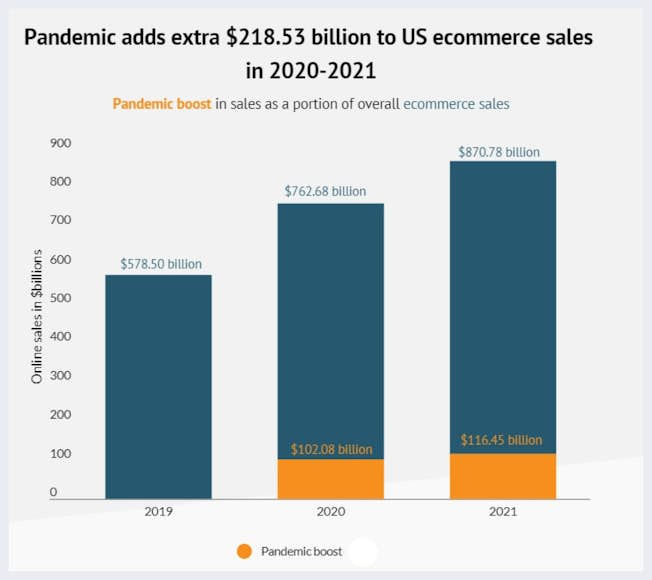Jun 7, 2022
What is Digital Transformation? A Guide for Businesses
Across industries, the Covid-19 pandemic forced many companies to accelerate their digital transformations to compete and even survive.
As the world and its consumers become more digital, a company’s success is contingent on how digital it can become. This applies to both B2C and B2B sectors as consumer behaviors, knowledge consumption and processes have now changed.
In 2022, spending on digital transformation technologies and services is projected to reach $1.8 trillion and increase to $2.8 trillion by 2025 according to Statista. That growth demonstrates how much companies are planning to invest to compete.
So, how can your business drive its transformation to be where your customers are? And what strategies are different industries using to ensure their long-term survival in a digital world?
In this blog, we’ll dive into the ins and outs of digital transformation by exploring:
- Digital transformation definition
- Steps to digital transformation
- Examples of digital transformation
- Benefits of digital transformation
- Digital transformation trends
- Digital transformation mistakes
Digital transformation definition
So what is digital transformation? If you type that question into Google, you’ll get billions of results. There may be a misconception that digital transformation is just about technology, but that’s not the case.
Digital transformation is a foundational change in how an organization operates, communicates, and engages with customers. It’s a disruption to the ‘traditional’ way of operating to become more digital. It’s also about cultivating a digital culture and upskilling the people in your company as it takes a team to work through a transformation.
As Brian Corish, Managing Director of Accenture Interactive simply puts it: “Digital transformation is reinventing the business model. It’s reinventing processes”
What’s the difference between digitization, digitalization, and digital transformation?
There are a lot of terms when it comes to businesses and digital, so it’s easy to confuse them. The most commonly used ones are digitization, digitalization, and digital transformation. Let’s look at each of them to see the difference.
- Digitize or digitization is the process of making something digital or creating it in a digital form. For example, if you create an online version of a printed newsletter or magazine, or use an electronic signature for signing documents online.
- Digitalization is about using digital technologies to change your business model or provide a new stream of revenue. It’s about using online technologies and channels to become a digital business. An example is using cloud computing to store data or automation to streamline workflows.
- Digital transformation is a process of reinvention. It looks at leveraging digital technologies and processes to build new systems, cultivate a digital mindset and exploit new opportunities.
Types of digital transformation
Many organizations focus on organizational transformation, but there are four types of digital transformation that you need to consider to realize its full value. These include:
- Process Transformation - This focuses on your processes such as data, analytics, AI, and any process that can work towards lowering costs and driving operational efficiency in the business. Healthcare retail giant Walgreens is a good example of this in how it relaunched its MyWalgreens app to centralize its digital assets and provide a better customer experience.
- Business Model Transformation - This is about making fundamental changes in how a business or organization runs which can include personnel, processes, and technology. For example, think about the powerhouse that is Netflix and how it revolutionized the video distribution industry by turning the model completely on its head.
- Domain Transformation - This area offers a great opportunity to move into a new domain or area that a business may not have explored before by acquiring new technologies. Think about Google and its many business offshoots such as Google Nest, an Internet of Things (IoT) product that provides thermostats and smoke detectors in the home.
- Cultural/Organizational Transformation - This is about redefining mindsets, processes, capabilities and skills for a digital world. It’s about driving digital transformation forward through growth initiatives that are grounded in a new culture and way of thinking. Pitney Bowes is a great example here as it pivoted from a mailing solutions company to a shipping and ecommerce technology company that transformed into a digital business.
6 Steps to Digital Transformation
Digital transformation is a long and complex process so it’s important to take a strategic approach from the outset. That means that you should build a digital transformation framework so you can always revisit a step to see if improvements can be made. The following six steps are key:
1. Understand why you are doing it
A key part of digital transformation is understanding the motivations for becoming more digital. No two businesses are the same, so it’s important to know why your business is embarking on this journey.
Think about the core reasons for your transformation. Is it to improve customer experience, increase the efficiency of your processes or manage your data? Once you know the reasons, you can plan forward to ensure they are met.
2. Audit your company
To know where you need to go, you need to know where your company is now. Review what processes and systems are in place and how effectively they are operating. If you are using digital tools and technologies, what are they and are they actually working? Examine the workings of your organization, how it is structured, and how it operates?
3. Find your gaps
The reason you are looking to drive digital transformation is that there are inefficiencies in the business, or opportunities you have not tapped into. What gaps need to be filled? For example, are you extracting value from your customer data? Do you have a way to engage and retain leads that come into the business? What’s your customer experience like from one channel to the next?
You can look at some of our case studies to see how global companies identify the gaps in their business.
4. Look at your in-house capabilities
Above and beyond technology, this stage is about looking at your talent. There’s no point in transforming your business if the digital skills aren't there to steer it. What digital skills are needed to drive transformation and do you have any in the company? Do you have a training program that can upskill existing employees so they have essential digital skills or at least digital literacy?
5. Create a digital transformation strategy
Once you understand your motivations, capabilities, gaps and in-house talent, it’s time to create a digital transformation strategy that can guide your business. This should act as a roadmap for you to follow that will be tied to KPIs with a funding plan in place.
6. Review and revisit - be agile!
Your digital transformation strategy should not be set in stone. The digital and customer ecosystems change constantly so it’s important to make room to review your strategy if external or internal factors warrant it. Agility is essential when navigating this type of transformation and your company needs to be able to pivot and adapt if required.
3 Great Examples of Digital Transformation
There are some great examples of organizations that are nailing digital transformation. Here are three well-known brands in different industries to give you inspiration on what can be achieved.
Domino’s

The well-known pizza chain Domino’s started in the 1960s and has transformed to become a ‘truly digital-first business’. In 2021, 91% of its sales were made through digital channels, according to Marketing Week.
Where it was once looking at bankruptcy, the bricks-and-mortar business turned things around in 2011. The then-CEO tasked the IT team to make it easy for any customer with a smartphone to order a pizza in the 17 seconds it takes for a light to turn green!
The Domino’s app was born (and the restaurant industry disrupted) and delivery is now made even easier as e-bikes and autonomous delivery have transformed the business into one that brought in revenue of $4.36 billion in 2021.
Nike

As one of the biggest brands on the planet, Nike’s swoosh logo is instantly recognizable. But even Nike needed to undergo a digital transformation to remain competitive and be where their customer was - online.
Armed with strong leadership, Nike transformed the company’s mindset, supply chain, and brand. The company focused on more powerful data analytics, updated its e-commerce strategy, devised powerful digital marketing campaigns, and ramped up its direct-to-customer sales. In addition, concept stores were piloted in 2018 and membership opportunities were expanded.
The brand also uses social media effectively for brand awareness, customer engagement and promoting its social initiatives to build a community. This series of posts on Twitter is to promote Mental Health Awareness Week amongst athletes.

Nike’s CFO, Matt Friend said: “Consumers continue to shift toward digital to find the products they love, and NIKE’s digital experience continues to build deep consumer connections and capture digital market share over the past four years.”
IKEA

Anyone who has furnished a house will be familiar with IKEA. Founded by Ingvar Kamprad when he was just 17, the company has gone on to become one of the most successful brands and one that’s not afraid of innovation.
Its transformation to digital has always been aggressive as it constantly strives to use technologies and channels to engage customers and drive sales. It embraces an omnichannel approach to enable customers to move from one channel to another easily.
IKEA’s decision to stop creating its well-known print catalog shifted investment to other areas. IKEA’s acquisition of Geomagical Labs will enable customers to create a 3D representation of a room, ‘delete’ the existing furniture and virtually add new pieces. The brand is also planning a ‘Shop and Go’ payment service, a geolocation system for in-store products and chatbots for simpler customer service.
How did COVID Accelerate Digital Transformation?
Ecommerce sales boomed during the Covid-19 pandemic. In the U.S. consumers spent $870 billion online in 2021, up 14% from 2020. According to Digital Commerce 360, if the pandemic had not happened, ecommerce sales would not have reached that level until 2023 (two years later).

As a result of the pandemic, companies turned to digital technologies and networks to reach and serve customers. For businesses that were already present online, this meant upscaling operations to meet demand. For those that had just started on their digital transformation journey, this called for an unexpected pivot.
According to a McKinsey Global Survey of executives, companies have accelerated the digitization of their customer and supply-chain interactions and internal operations by three to four years. Meantime, the share of digital or digitally enabled products has accelerated by seven years.
There were also significant changes to companies during this time such as remote working (including the explosion of people working as digital nomads across cities), changing customer needs and preferences, along with cloud migration. McKinsey’s survey discovered that many executives believe these changes will remain in the business.

Ultimately, the pandemic has created a new way of working for companies across sectors.
Digital transformation across industries
No industry has been untouched by digital transformation. To serve its customers and compete, companies across sectors are investing in digital transformation to embed digital in their processes and culture.
Let’s look at several industries to see the areas of transformation and future trends.
Digital transformation in governance
Privacy and adherence to regulations is key in this sector and as a result, it’s been slow to digitally transform. A report from Deloitte found that only 30 percent of organizations surveyed assessed their digital capabilities as ahead of their public sector peers while 70 percent said they lagged behind the private sector.
The digital transformation challenges for governance are:
- Data collection and protection
- Information sharing
- Siloed strategies
- Cost and budget pressures
- A risk-averse culture
- Skills gaps
The key to overcoming these challenges and becoming more of a digital sector are:
- A transition to cloud
- Secure access to communications
- Cross-functional information sharing
- Digital skills training
Digital transformation in healthcare
The global digital health market is expected to increase to over $500 billion by 2025 with health information technology being the largest share. The sector faces a number of challenges in its transformation:
- Patient delivery and service
- Speed of care
- Privacy
- Data collection and management
However the pandemic accelerated change in this sector rapidly due to shifting consumer preferences and care-delivery innovation which includes:
- Remote patient monitoring
- AI-based automation e.g. image-guided therapy
- Tele-ICUs
- Tele prescribing
Digital transformation in financial services and banking
While 92% of finance leaders have started their journey to introduce digital interventions, only 11% believe they are at an advanced stage according to EYs Digital Survey.
The challenges that the financial sector face is related to the protection of sensitive information and data.
- Management reporting
- Transaction accounting
- Real-time data analytics and data management
- Compliance and privacy
Coming down the line in 2022 and beyond are digital transformation initiatives to increase security and provide a better customer experience.
- Touchless transactions
- Hyper-personalization
- Super apps
Big techs like Google and Apple ramp up activities in the sector
Digital transformation in manufacturing
Digital transformation in the manufacturing market is expected to reach $767 billion by 2026 with increased spending on IoT.
The challenges this industry faces are:
- Ecommerce - selling to a business
- Big data and data analytics
- Real-time data
Like the financial sector this industry had to accelerate its digital transformation during the pandemic and ramped up activities in certain areas to make improvements such as:
- Robotics
- AR for assembly lines
- 3D printing
- B2B ecommerce
- IoT for real-time data
Digital transformation in small business
72% of small businesses are accelerating their digitalization rates to address COVID-19 challenges according to ‘2020 Small Business Digital Transformation’.
Unlike large corporations, small businesses can use the fact they are smaller to their advantage. This may make it easier to make changes in the company’s mindset, enable specialized training programs that focus on key areas and see digital technologies and strategies have an instant impact. The challenges small businesses face are:
- Improving operations and service delivery
- Customer experience
- Market expansion
- Sales and marketing
- Talent sourcing
However, strategies are being made to tackle each of these by
- Automating or digitizing processes
- Investing in talent and digital skills
- Improving online sales and digital payments
Digital transformation in HR
The HR market is expected to reach $43 billion by 2028. The growth is driven by the adoption of HR software. Challenges faced by this sector are:
- Optimize workplace experience
- Increasing efficiencies
- Upskill and train staff
- Workflow automation
- Talent management
These obstacles are being tackled by the HR industry across the globe by introducing:
- New ways of working - remote, hybrid
- Digital learning platforms
- Social talent acquisition
- People analytics
- Ongoing performance management
- Cloud-based HR
Benefits of digital transformation
There are many benefits to digital transformation for a business and its workforce which include:
- Transforms customer experience
- Drives data-based insights
- Encourages collaboration
- Improves employee experience
- Boosts innovation and agility
- Updates skills and knowledge
- Fosters a digital culture
- Consolidates process & operations
For a more detailed description, read our blog ‘What are the Benefits of Digital Transformation?’
Digital transformation commercial trends 2022
From a commercial perspective, companies are looking to embed digital across the business in the most effective ways possible. Some of these ways are:
- Consider a new digital business model - Any model should be tailored to your own business. Look at your products or services and see how online technologies and channels can help you to create a seamless customer experience and make more sales. It could be as simple as setting up an ecommerce store or focusing on social commerce.
- Focus on employee onboarding - You can have all the technology and tools in the world, but if your employees don't know how to use it there’s no point in having it. Ensure that you create an onboarding program for new employees so that they know what digital tools are available and how to use them.
- Implement personalization without impacting privacy - The issue with becoming more personalized in communications is you need customer data to do that. And today many consumers are worried about providing confidential information. The best way to achieve this is to be transparent and look at ways to collect zero-party data.
- Digital workplace tools - Hybrid and remote working are now the new normal and this requires collaborative tools to function properly. There are many tools on the market for communication, project management, and document sharing such as Zoom, Slack, and Monday.
- Digital upskilling - There’s no denying that there’s a global digital skills shortage across businesses. If you can’t find talent, what’s the solution? Upskill existing staff in new skills so they can not only perform new functions and be innovative but also advance their careers.
Digital transformation tech trends for 2022
As digital continues to accelerate across industries, it’s important to keep the process and mindset we set out above. However, these are the key technology trends in 2022 and beyond.
- 5G - The fifth generation of mobile networks is here and it will enable faster connection speeds, ultra-low latency and greater bandwidth that will transform industries and enhance day-to-day experiences. This will enable advanced services in e-health, connected vehicles and traffic systems and mobile cloud gaming.
- Zero-trust security - With the rise in hacking and cyber attacks, businesses are looking to implement a zero-trust security model. This will help secure applications, identity, data, networks, and infrastructure.
- Hyperautomation - This can be defined as “automation on steroids” where companies can do business and IT processes through Robotic Process Automation, low-code/no-code adoption, or AI and Machine Learning (ML).
- Predictive analytics - By analyzing historical data using AI and ML and correlating it with factors such as economic, business environment, and consumer behavior patterns, predictive analytics tools will allow businesses to make predictions.
- Customer Relationship Management and Customer Data Platforms - As customer data becomes more precious and important (find out about zero-party data), companies will invest in better platforms for their customer data. By cross-referencing data across these platforms, it will be easier to get insights.
- Generative AI - This refers to AI programs that can use existing content such as text, images or audio to create new content. For example, using FaceApp to upload an image and see how a person would look at different ages.

5 Digital Transformation Mistakes to Avoid
70% of digital transformations fall short of their objectives according to a BCG report. That means that there can be a lot against you in your digital transformation journey. So, let’s look at the things you should avoid to ensure transformation success.
- Having the wrong data - It’s not about quantity but quality when it comes to data and companies need to make sure they are looking at the right data and driving insights to move forward.
- Resistance from staff - When staff do not understand the reasons and benefits of change, then there will be pushback. Make sure your workforce knows the motivations for a digital transformation and the benefits to the business and customers.
- Underestimate costs - Digital transformation is an expensive process as it’s a reinvention of a business. Make sure you approach it with a budget that can deliver on your expectations and goals.
- A lack of commitment - This is a long process that will take time and commitment. Make sure your business has a multi-year plan to guide the process and an expectation across the company that time is required.
- A lack of skills - To transform your business requires manpower and often companies do not have the knowledge and skills required. Training can have a huge impact on staff skills, so think about creating or bringing in a tailored program that covers the specific areas your company needs to thrive.
Drive Digital Transformation Success for Your Business & Workforce
Digital transformation is a complex process and the people part of it is just as important as the technology. At DMI we can help you drive ecommerce sales, build pipelines, develop online relationships and embed digital across the organization. Check out our business page to see how your company can succeed in a competitive marketplace.
Related
Upgrade to Power Membership to continue
your access to thousands of articles, toolkits, podcasts, lessons and much much more.
Become a Power Member- Login
- View Courses
- - - -
- Courses
- Resources
- - - -
- My Account
- Change Password
- Logout





